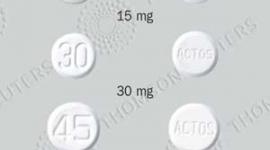Starlix Diabetes Type 2 Treatment - Starlix Patient Information
Brand Name: Starlix
Generic name: Nateglinide (oral)
Pronounced: na-ta-GLYE-nide
Starlix, nateglinide (oral), full prescribing information
What is Starlix and what is it used for?
Starlix is an oral diabetes medicine that helps control blood sugar levels. Starlix helps your body respond better to insulin produced by your pancreas.
Starlix is used together with diet and exercise to treat type 2 (non-insulin dependent) diabetes. Other diabetes medicines are sometimes used in combination with if needed.
Important information about Starlix
Do not use Starlix if you are allergic to nateglinide, if you have type 1 diabetes, or if you are in a state of diabetic ketoacidosis (call your doctor for treatment with insulin).
Starlix is only part of a complete program of treatment that also includes diet, exercise, and weight control. Follow your diet, medication, and exercise routines very closely. Changing any of these factors can affect your blood sugar levels.
It is important to take Starlix regularly to get the most benefit. Get your prescription refilled before you run out of medicine completely.
Take care not to let your blood sugar get too low, causing hypoglycemia. You may have hypoglycemia if you skip a meal, exercise too long, drink alcohol, or are under stress.
Know the signs of low blood sugar (hypoglycemia) and how to recognize them. Always keep a source of sugar available in case you have symptoms of low blood sugar. Sugar sources include orange juice, glucose gel, candy, or milk. Severe hypoglycemia may cause loss of consciousness, seizures, or death. If you have severe hypoglycemia and cannot eat or drink, use an injection of glucagon. Your doctor can give you a prescription for a glucagon emergency injection kit and tell you how to give the injection. If your blood sugar gets too high (hyperglycemia), you may feel very thirsty or hungry. You may also urinate more than usual. Call your doctor right away if you have any symptoms of hyperglycemia. Starlix may also be used for other purposes not listed in this medication guide.
Before taking Starlix
Do not use this medication if you are allergic to nateglinide, if you have type 1 diabetes, or if you are in a state of diabetic ketoacidosis (call your doctor for treatment with insulin).
Before taking Starlix, tell your doctor if you are allergic to any medications, or if you have liver disease or gout. You may need a dose adjustment or special tests to safely take Starlix.
FDA pregnancy category C. This medication may be harmful to an unborn baby. Tell your doctor if you are pregnant or plan to become pregnant during treatment. It is not known whether Starlix passes into breast milk or if it could be harmful to a nursing baby. Do not take Starlix without telling your doctor if you are breast-feeding a baby.
How should I take Starlix?
Take Starlix exactly as it was prescribed for you. Do not take Starlix in larger or smaller amounts, or take it for longer than recommended by your doctor. Follow the directions on your prescription.
Your dose needs may change if you are ill, if you have a fever or infection, or if you have surgery or a medical emergency. Do not change your dose of Starlix without first talking to your doctor. Take this medicine with a full glass of water.
Starlix is usually taken 3 times daily, within 30 minutes before eating a meal. Follow your doctor's instructions. If you skip a meal, do not take your dose of Starlix. Wait until your next meal.
Take care not to let your blood sugar get too low, causing hypoglycemia. You may have hypoglycemia if you skip a meal, exercise too long, drink alcohol, or are under stress.
Know the signs of low blood sugar (hypoglycemia) and how to recognize them. Always keep a source of sugar available in case you have symptoms of low blood sugar. Sugar sources include orange juice, glucose gel, candy, or milk. Severe hypoglycemia may cause loss of consciousness, seizures, or death. If you have severe hypoglycemia and cannot eat or drink, use an injection of glucagon. Your doctor can give you a prescription for a glucagon emergency injection kit and tell you how to give the injection.
To be sure this medication is helping your condition, you will need to check your blood sugar at home. Your blood will also need to be tested by your doctor on a regular basis. It is important that you not miss any scheduled visits to your doctor.
Starlix is only part of a complete program of treatment that also includes diet, exercise, and weight control. Follow your diet, medication, and exercise routines very closely. Changing any of these factors can affect your blood sugar levels.
It is important to take Starlix regularly to get the most benefit. Get your prescription refilled before you run out of medicine completely.
Store Starlix at room temperature away from moisture and heat.
What happens if I miss a dose?
Take the missed dose as soon as you remember, but only if you are getting ready to eat a meal. If it is almost time for the next dose, skip the missed dose and take only the next regularly scheduled dose. Do not take a double dose of this medication.
What happens if I overdose?
Seek emergency medical attention if you think you have used too much of this medicine. Starlix overdose symptoms may include hunger, nausea, anxiety, cold sweats, weakness, drowsiness, loss of consciousness, and coma.
What should I avoid while taking Starlix?
Avoid drinking alcohol. It lowers blood sugar and may interfere with your diabetes treatment.
Do not use Starlix if you are in a state of diabetic ketoacidosis. Call your doctor for treatment.
Starlix side effects
Get emergency medical help if you have any of these signs of an allergic reaction: hives; difficulty breathing; swelling of your face, lips, tongue, or throat. Call your doctor at once if you have any of these serious side effects:
- seizure (convulsions); or
- jaundice (yellowing of the skin or eyes).
Less serious side effects may include:
- runny or stuffy nose, sneezing, cough, cold or flu symptoms;
- diarrhea, nausea;
- back pain;
- dizziness; or
- joint pain or stiffness.
This is not a complete list of side effects and others may occur. Tell your doctor about any unusual or bothersome side effect. You may report side effects to FDA at 1-800-FDA-1088.
What other drugs will affect Starlix?
You may be more likely to have hyperglycemia (high blood sugar) if you are taking Starlix with other drugs that raise blood sugar. Drugs that can raise blood sugar include:
- isoniazid;
- diuretics (water pills);
- steroids (prednisone and others);
- phenothiazines (Compazine and others);
- thyroid medicine (Synthroid and others);
- birth control pills and other hormones;
- seizure medicines (Dilantin and others); and
- diet pills or medicines to treat asthma, colds or allergies.
You may be more likely to have hypoglycemia (low blood sugar) if you are taking Starlix with other drugs that lower blood sugar. Drugs that can lower blood sugar include:
- nonsteroidal anti-inflammatory drugs (NSAIDs);
- aspirin or other salicylates (including Pepto-Bismol);
- sulfa drugs (Bactrim and others);
- a monoamine oxidase inhibitor (MAOI);
- beta-blockers (Tenormin and others); or
- probenecid (Benemid).
This list is not complete and there may be other drugs that can interact with Starlix. Tell your doctor about all the prescription and over-the-counter medications you use. This includes vitamins, minerals, herbal products, and drugs prescribed by other doctors. Do not start using a new medication without telling your doctor.
Where can I get more information?
- Your pharmacist can provide more information about Starlix.
What does my medication look like?
Nateglinide is available with a prescription under the brand name Starlix. Other brand or generic formulations may also be available. Ask your pharmacist any questions you have about this medication, especially if it is new to you.
- Starlix 60 mg - round, pink tablets
- Starlix 120 mg - oval, yellow tablets
- Remember, keep this and all other medicines out of the reach of children, never share your medicines with others, and use this medication only for the indication prescribed.
Last revised 04/2009
Starlix, nateglinide (oral), full prescribing information
Detailed Info on Signs, Symptoms, Causes, Treatments of Diabetes
back to: Browse all Medications for Diabetes
APA Reference
Staff, H.
(2009, April 30). Starlix Diabetes Type 2 Treatment - Starlix Patient Information, HealthyPlace. Retrieved
on 2025, November 28 from https://www.healthyplace.com/diabetes/medications/starlix-diabetes-treatment-information



